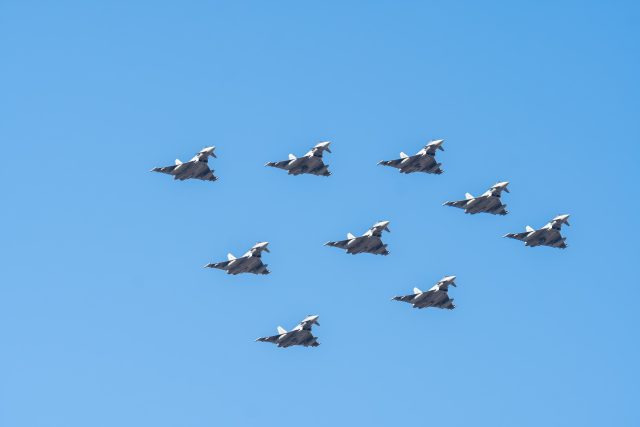
The analysis of recent European military exercises, specifically the “Joint Stars” simulation, raises important questions about Europe’s defensive capacity in the face of large-scale air threats. In this context, the simulation of a Russian missile attack on the city of Cagliari, in Italy (Sardinia), represents an emblematic case of the structural and strategic shortcomings of the current continental defence systems. The event, although virtual, offered a particularly significant test bench to evaluate the effectiveness of the European anti-aircraft shield and fueled a political-military debate on the state of readiness of the Union’s defence apparatus.
A VIRTUAL ATTACK, REAL CONSEQUENCES
As part of the “Joint Stars” exercise, which ended two weeks ago, the Italian armed forces tested their ability to respond to an air war scenario similar to the one currently underway in Ukraine. The tactical model envisages an attack in three waves: first drones, then ballistic missiles, and finally cruise missiles. According to journalistic sources, six missiles would have succeeded (hypothetically) in hitting Cagliari despite the use of the best available defence systems, such as the destroyer Doria and a Samp-T surface-to-air battery. As stated by various media, the words of General Nicola Piasente are emblematic, according to whom the current context of threat requires the adoption of a multi-level air defence system capable of operating effectively at low, medium and high altitudes. This vision also appears to be shared by NATO Secretary General Mark Rutte, who recently highlighted how the attack methods adopted by the Russian Federation in Ukraine (characterized by systematic air offensives) demonstrate the urgent need to strengthen European defence capabilities, in order to ensure effective protection of the Alliance’s airspace.
EUROPEAN INDUSTRIAL DELAY
The critical issues are not limited to the operational and strategic sphere. They are grafted onto a production system that is still largely unsuitable to support a growing and urgent demand for armaments. The European defence industry, particularly in the surface-to-air missile sector, is represented by a multinational consortium – MBDA – established by France, Italy, the United Kingdom and Germany. This cooperative model, although virtuous in its conception, presents serious logistical inefficiencies. The production of a single Aster 30 missile required up to 41 months in 2022; currently, thanks to optimization interventions, the time has been reduced to 18 months, with the aim of further improvement in the two-year period 2025-2026. The Italian Minister of Defence, Guido Crosetto, has announced that national production of missiles will increase by 40% by 2025, with a subsequent duplication expected for the following year. Despite these prospects of industrial strengthening, the indicated timeframes still appear insufficient to satisfy both Ukraine’s urgent operational needs and the broader deterrence needs of the European Union. In this context, the European Commissioner for Defence, Andrius Kubilius, highlighted how the European regulatory apparatus, conceived in an era in which armed conflict seemed remote, is no longer adequate to the changed geopolitical scenario. He underlined the urgency of overcoming the current administrative obstacles, warning that the timeframes imposed by bureaucracy cannot compete with the speed of the Russian military escalation.
THE “PERFECT STORM” AND THE RISK OF SYSTEMIC VULNERABILITY
According to Kubilius, Europe is facing a “perfect storm”, given by the convergence of structural, strategic and bureaucratic factors that limit its defensive capacity. This scenario is aggravated by the increasing speed of the Russian military-industrial complex, capable of producing over 25,000 Geran drones, 800 Iskander ballistic missiles and 633 KH101 cruise missiles in 2025 alone. A production rate that far exceeds the European one and seriously endangers the continent’s strategic autonomy. Western reserves of Samp-T systems are already exhausted, while the United States, the main suppliers of weapons to Ukraine, currently produces only 42 Patriot missiles per month, an insufficient number to respond to the Russian attacks of recent days. This imbalance between production capacity and defensive needs is also reflected in the reluctance of European chancelleries to give up their equipment, in the absence of rapid replacement tools. The simulation of the attack on Cagliari is, therefore, not just an academic or tactical exercise, but a severe warning for European defence policy. It highlights the inadequacy of the continent’s current military architecture in the face of hypothetical but increasingly plausible threats. The declarations of the military and institutional leaders converge on an imperative need: to provide Europe with a multilayered air defence and an efficient and rapid industrial capacity, capable of responding to both emergencies and the structural challenges of the future. In a rapidly evolving geopolitical context, the ability to react as well as Europe’s collective security will depend on the speed with which the Union will be able to transform its war industry into a strategic engine, not only for the defence of its citizens, but for maintaining the international balance.



 Subscribe
Subscribe